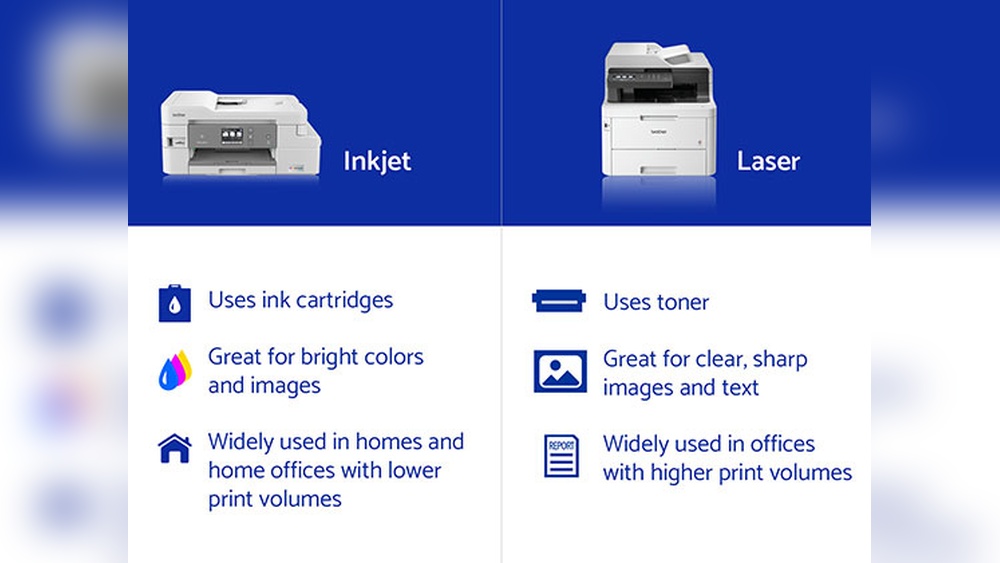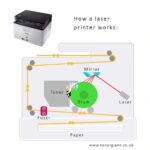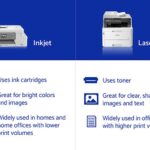Choosing the right printer for your office can feel overwhelming, especially when you’re stuck between laser and inkjet toner options. You want a solution that saves you time, cuts costs, and delivers clear, professional-quality prints every single day.
But which technology truly fits your office’s needs? Should you prioritize speed and efficiency, or is vibrant color output more important? You’ll discover the key differences between laser and inkjet toner printers, helping you make a smart choice that keeps your office running smoothly and your budget intact.
Keep reading to find out which printer type will work best for your unique workspace demands.
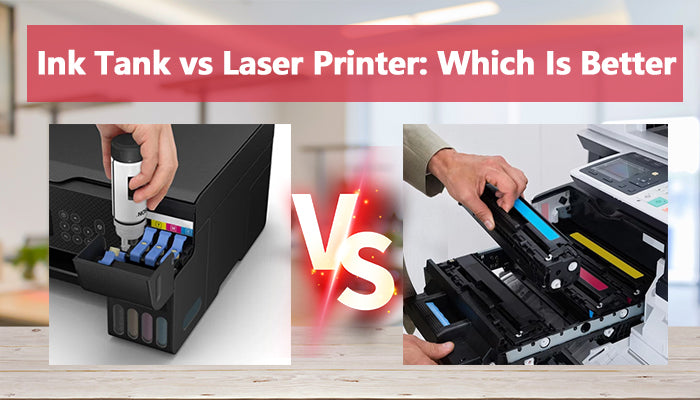
Credit: trueimagetech.com
Laser Printer Basics
Laser printers are common in many offices. They are known for speed and efficiency. These printers handle large print volumes easily. They suit businesses that print many documents daily.
Understanding how laser printers work helps in choosing the right printer. It also shows why they are preferred in offices.
How Laser Printing Works
Laser printers use a laser beam to create images on paper. The laser draws the image on a drum with static electricity. Toner particles stick to the charged areas on the drum.
The toner is then transferred to paper and fused using heat. This process produces sharp text and clear images fast. The printing happens quickly, making it ideal for busy offices.
Key Features For Offices
Laser printers print documents much faster than inkjets. Speed is important in office environments. These printers have a lower cost per page, saving money over time.
They offer high reliability and can handle large paper loads. Toner cartridges last longer than ink cartridges, reducing maintenance needs. Laser printers also avoid ink clogging problems common in inkjets.
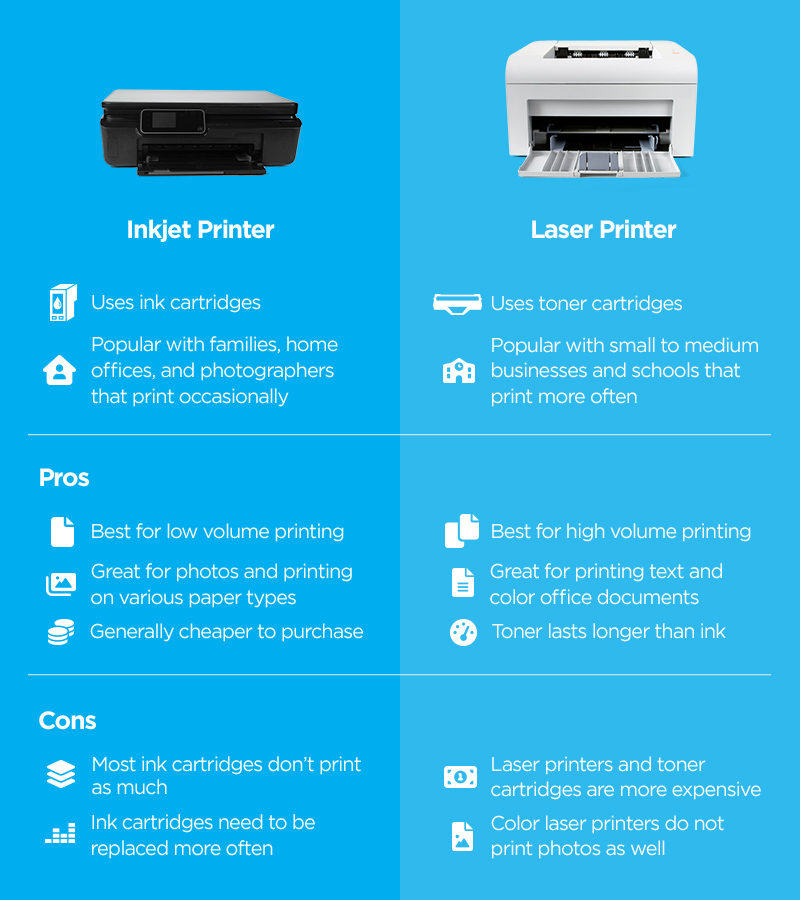
Credit: www.ldproducts.com
Inkjet Printer Basics
Understanding the basics of inkjet printers helps offices decide on the right printing technology. Inkjet printers use liquid ink to create images and text on paper. They are popular for their ability to produce high-quality color prints. These printers work best for low to medium print volumes. Their compact size fits well in small office spaces. Inkjet printers offer flexibility for various printing needs.
How Inkjet Printing Works
Inkjet printers spray tiny droplets of ink directly onto paper. The ink comes from small nozzles in the print head. These droplets form images and text by layering colors precisely. The printer mixes colors like cyan, magenta, yellow, and black. This process allows smooth color gradients and detailed photos. Inkjet printing happens at room temperature, which prevents paper damage. The printer moves the paper slowly to ensure accurate ink placement. After printing, the ink dries quickly to avoid smudging.
Key Features For Offices
Inkjet printers excel in producing vibrant color prints and photos. They handle various paper types, including glossy and specialty papers. These printers are usually affordable upfront, making them accessible for small offices. Inkjet devices are quieter than laser printers during operation. Their smaller size helps save desk space in busy environments. Inkjet printers require regular ink cartridge replacements, which can add to costs. They suit offices with occasional print jobs and color needs. Inkjets are less ideal for very high-volume printing due to slower speeds.
Print Quality Comparison
Print quality plays a key role in choosing between laser and inkjet printers for offices. Clear, sharp, and vibrant prints improve communication and professionalism. Each printer type handles print quality in unique ways. Understanding these differences helps pick the right printer for your office needs.
Text Clarity And Sharpness
Laser printers excel at producing crisp and sharp text. They use toner, which fuses to the paper, creating clean edges on letters. This makes laser prints easy to read, ideal for documents and reports. Inkjet printers spray tiny droplets of ink, which may cause slight bleeding. Text may look softer, especially on lower-quality paper. For heavy text printing, laser printers usually deliver better clarity.
Color Accuracy And Vibrancy
Inkjet printers generally offer richer and more vibrant colors. They blend inks smoothly, producing a wide color range and subtle shades. This feature suits marketing materials and colorful presentations. Laser printers use toner powders that can sometimes produce less accurate colors. Brightness and saturation may appear duller compared to inkjet prints. For color-sensitive office work, inkjets often provide superior results.
Photo And Graphic Output
Inkjet printers are preferred for photo and graphic printing. They can reproduce fine details and gradients better due to their precise ink spraying technology. Photos look more natural and lifelike on inkjet prints. Laser printers struggle with photo quality, as toner can create a grainy texture. Graphics with sharp lines print well on laser devices but may lack the smoothness inkjets offer. Offices needing high-quality images benefit from inkjet technology.
Speed And Efficiency
Speed and efficiency are critical factors for office printing tasks. Choosing the right printer affects daily workflow. Fast printing saves time and reduces waiting. Efficient devices manage large workloads without delays. This section compares laser and inkjet printers on these points.
Print Speed Differences
Laser printers print pages much faster than inkjets. They use a quick laser beam to transfer toner onto paper. Inkjet printers spray tiny droplets of ink, which takes longer. Offices benefit from laser printers when speed is essential. Fast printing keeps work moving without bottlenecks. Inkjet printers suit slower, less frequent tasks.
Handling Large Volumes
Laser printers handle large print volumes with ease. Their toner cartridges last longer and print thousands of pages. They also have larger paper trays to reduce refilling. Inkjet printers require frequent ink replacement during heavy use. Laser printers are designed for continuous, high-demand printing. This makes them ideal for busy office environments.
Cost Analysis
Cost analysis plays a vital role in choosing between laser and inkjet toner for offices. Understanding the expenses helps businesses control budgets and improve printing efficiency. This section breaks down the key cost factors for both types.
Initial Purchase Price
Inkjet printers often have a lower initial purchase price. They are affordable for small offices or occasional use. Laser printers usually cost more upfront. The higher price reflects faster printing and greater durability. Offices with heavy print demands often find laser printers worth the investment.
Cost Per Page
Laser printers have a lower cost per page. Toner cartridges last longer and print thousands of pages. Inkjet printers use ink cartridges that run out faster. Their cost per page tends to be higher, especially for black and white prints. For large print volumes, laser printers save more money over time.
Maintenance And Consumables
Inkjet printers need frequent ink cartridge replacements. They may also require printhead cleaning to prevent clogs. Laser printers require toner cartridge changes less often. Maintenance is simpler and less frequent with laser devices. Both types need paper and occasional parts replacement, but laser printers generally have lower ongoing costs.
Reliability And Maintenance
Reliability and maintenance are key factors when choosing between laser and inkjet printers for office use. Offices need printers that work consistently without frequent breakdowns. Maintenance should be simple and not interrupt daily tasks. Understanding these aspects helps in picking the right printer that meets office demands efficiently.
Durability In Office Use
Laser printers are built for heavy use. They handle large print volumes without losing quality. Their parts last longer under constant use. Inkjet printers are better for low to medium print volumes. They may wear out faster if used heavily. Offices printing many pages daily benefit from laser printers’ durability. Inkjet printers suit offices with lighter printing needs.
Common Maintenance Issues
Laser printers need occasional toner replacement and drum cleaning. They rarely face ink drying or clogging problems. Inkjet printers often require cleaning print heads. Ink cartridges can dry out if unused for days. This causes poor print quality and jams. Laser printers usually need less frequent maintenance. Inkjet printers demand more care to stay reliable.
Use Cases In Offices
Choosing between laser and inkjet printers depends largely on office needs. Each printer type suits different tasks and business sizes. Understanding their use cases helps pick the right printer for your office.
Best For Text-heavy Documents
Laser printers excel in printing sharp, clear text quickly. They handle large volumes of documents without slowing down. Offices with heavy printing demands benefit from laser technology. It reduces wait times and keeps productivity high. Text documents like reports, invoices, and memos print crisply. Toner lasts longer, lowering overall printing costs. Laser printers work well for black-and-white and simple color text.
Best For Creative And Color Work
Inkjet printers produce vibrant colors and smooth gradients. They suit offices that print marketing materials or presentations. Photos and detailed images look better with inkjet printers. Color accuracy and blending are stronger than with lasers. Inkjets handle various paper types like glossy and textured sheets. These printers are ideal for creative tasks needing high-quality color output. Ink cartridges can be costly but offer excellent color richness.
Suitability For Small Vs Large Businesses
Small businesses often print less frequently, so inkjets fit well. They cost less upfront and handle occasional printing needs. Large businesses print high volumes daily, favoring laser printers. Laser machines are built for durability and long print runs. They offer lower cost per page and faster speeds. Businesses should consider print volume, budget, and document types. Matching printer type to business size saves money and boosts efficiency.
Environmental Considerations
Environmental considerations play a key role in choosing between laser and inkjet printers for offices. These factors affect not only the planet but also the office’s long-term sustainability. Understanding how each printer type impacts energy use and waste helps make a greener choice.
Energy Consumption
Laser printers use heat to fuse toner onto paper. This process requires more energy during printing. Inkjet printers operate by spraying tiny droplets of ink. They generally use less power while printing.
In standby mode, laser printers still consume considerable energy. Inkjet models often have lower standby power needs. Offices with high print volumes might find laser printers more energy-efficient per page printed. For lower volumes, inkjets can save energy overall.
Waste And Recycling
Laser printers use toner cartridges that last longer but create more plastic waste. Toner powder is also harder to recycle than ink. Inkjet cartridges are smaller and often come in refillable options. This reduces plastic waste in the long run.
Both printer types generate waste from packaging and cartridges. Proper recycling programs help reduce environmental impact. Some manufacturers offer cartridge return schemes for recycling. Choosing printers with eco-friendly certifications can support greener office practices.
Choosing The Right Printer
Choosing the right printer for your office is important. The printer must fit your work style and needs. Picking between laser and inkjet printers depends on several factors. This guide helps you decide which printer matches your office best.
Consider the volume of printing, quality required, and cost limits. These points affect the choice and help avoid extra expenses. A printer that suits your daily tasks will improve office efficiency.
Assessing Office Needs
Start by checking how much you print each day. Large offices print many pages, needing fast machines. Laser printers handle big volumes better and print quickly. Small offices or those printing less can use inkjet printers. Inkjets work well for color images and photo-quality prints.
Think about the type of documents printed. Text-heavy papers suit laser printers. Color-rich documents may need inkjet printers for better colors. Also, consider space and connectivity options for easy setup and use.
Balancing Quality And Cost
Print quality varies between laser and inkjet printers. Laser printers offer sharp text and clear graphics. Inkjet printers produce brighter colors and smooth images. Cost plays a big role in choosing the right one.
Laser printers have a higher upfront cost but lower cost per page. Inkjet printers cost less initially but use expensive ink cartridges. Maintenance costs also differ. Laser printers need less frequent replacement of toner. Inkjet cartridges may dry out if unused.
Choose a printer that balances quality with budget. This approach saves money and meets office needs without compromise.
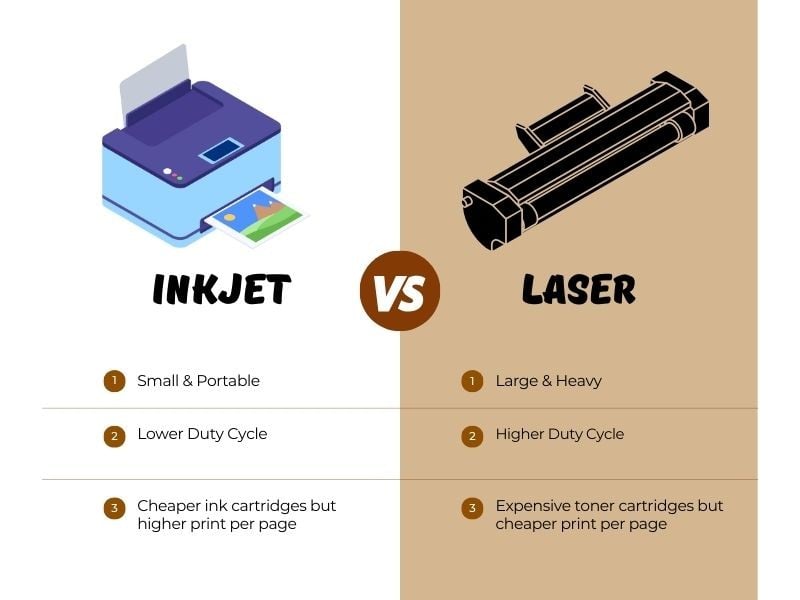
Credit: www.paperpapers.com
Frequently Asked Questions
Is Inkjet Or Laser Better For Office?
Laser printers suit offices better due to faster speed, lower cost per page, higher reliability, and excellent text quality. Inkjets excel in color photo printing but are slower and less cost-effective for high volumes. Choose laser for frequent, high-volume document printing in professional settings.
Is Laser Or Inkjet Better For Small Business?
Laser printers suit small businesses needing fast, high-volume, and cost-effective text printing. Inkjet printers work well for low-volume, color-rich, and photo printing tasks. Choose based on print volume and quality needs.
Do Offices Use Laser Printers?
Yes, offices widely use laser printers for their fast speed, reliability, and low cost per page. They handle high-volume printing efficiently and produce sharp, professional-quality text documents. Laser printers require less maintenance and suit busy office environments better than inkjet printers.
Are Office Copiers Laser Or Inkjet?
Office copiers mostly use laser technology for fast, reliable, and cost-effective high-volume printing. Inkjet copiers are rare in offices.
Conclusion
Choosing between laser and inkjet printers depends on your office needs. Laser printers work best for fast, high-volume text printing. Inkjet printers suit offices needing vivid color and photo-quality prints. Consider cost, speed, and print quality before deciding. Both types have strengths that fit different tasks.
Think about how often and what you print daily. This helps pick the right printer for your office.
Affiliate Disclosure
This website/blog/content contains affiliate links. This means if you click on one of these links and make a purchase, I may receive a small commission at no additional cost to you.
I only recommend products and services that I genuinely believe in and have personally used or thoroughly researched. While I do receive compensation for these recommendations, my opinions remain honest and unbiased.
The commissions earned help support this website and allow me to continue providing valuable content. I appreciate your support when you use these links, but you are never obligated to make purchases through them.
Please note that prices of products or services may vary, and I have no control over these prices or the availability of items. All recommendations are made based on my assessment at the time of posting.
Thank you for your understanding and support.

